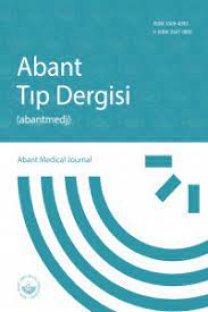Diyabetik polinöropatili hastalarda alfa lipoik asidin glisemik kontrol üzerine etkisi
Alfa lipoik asit, Glisemik kontrol, HbA1c
The effect of Alpha lipoic acid on glycemic control in patients with diabetic polyneuropathy
Alpha lipoic acid, Glycemic control, HbA1c,
___
- Edwards JL, Vincent AM, Cheng HT, Feldman EL. Diabetic neuropathy: mechanisms to management. Pharmacol Ther. 2008;120(1):1-34.
- Martin CL, Albers JW, Pop-Busui R; DCCT/EDIC Research Group. Neuropathy and Related Findings in the Diabetes Control and Complications Trial/Epidemiology of Diabetes Interventions and Complications Study. Diabetes Care. 2014; 37(1): 31–38.
- Hamed E, Monem MA. A review of diabetic peripheral neuropathy management given recent guidelines updates. Arch Gen Intern.Med. 2018;2(4):1-5.
- Hosseini A and Abdollahi M. Diabetic Neuropathy and Oxidative Stress: Therapeutic Perspectives. Oxid Med and Cell Longev. 2013.
- Gomes MB, Negrato CA. Alpha-lipoic acid as a pleiotropic compound with potential therapeutic use in diabetes and other chronic diseases. Diabetol Metab Syndr. 2014; 6(1) :80.
- Ziegler D, Nowak H, Kempler P, Vargha P & Low P.A. Treatment of symptomatic diabetic polyneuropathy with the antioxidant alpha-lipoic acid: a meta-analysis. Diabetic Medicine 2004; 21: 114–121.
- Ansar H, Mazloom Z, Kazemi F, Hejazi N. Effect of alpha-lipoic acid on blood glucose, insulin resistance and glutathione peroxidase of type 2 diabetic patients. Saudi Med J. 2011; 32: 584-8.
- Okanovic A, Prnjavorac B, Jusufovic E, Sejdinovic R. Alpha- lipoic acid reduces body weight and regulates triglycerides in obese patients with diabetes mellitus. Medicinski glasnik: official publication of the Medical Association of Zenica-Doboj Canton, Bosnia and Herzegovina. 2015; 12:122
- de Oliveira AM, Rondo PH, Luzia LA, D'Abronzo FH, Illison VK. The effects of lipoic acid and alpha-tocopherol supplementation on the lipid profile and insulin sensitivity of patients with type 2 diabetes mellitus: a randomized, double- blind, placebo-controlled trial. Diabetes research and clinical practice. 2011; 92:253-60.
- Kamenova P. Improvement of insulin sensitivity in patients with type 2 diabetes mellitus after oral administration of alpha-lipoic acid. Hormones (Athens). 2006;5(4):251-8.
- Cummings BP, Stanhope KL, Graham JL, Evans JL, Baskin DG, Griffen SC, Havel PJ. Dietary fructose accelerates the development of diabetes in UCD-T2DM rats: amelioration by the antioxidant, alpha-lipoic acid. Am J Physiol Regul Integr Comp Physiol. 2010;298: R1343-50
- Park KG, Min AK, Koh EH, Kim HS, Kim MO, Park HS, Kim YD, Yoon TS, Jang BK, Hwang JS, Kim JB, Choi HS, Park JY, Lee IK, Lee KU. Alpha-lipoic acid decreases hepatic lipogenesis through adenosine monophosphate-activated protein kinase (AMPK)-dependent and AMPK-independent pathways. Hepatology. 2008; 48:1477-86.
- Young MJ, Boulton AJ, MacLeod AF, Williams DR, Sonksen PH. A multicentre study of the prevalence of diabetic peripheral neuropathy in the United Kingdom hospital clinic population. Diabetologia 1993; 36 :150-154.
- Papanas N, Ziegler D. Efficacy of α-lipoic acid in diabetic neuropathy. Expert Opin Pharmacother. 2014;15(18):2721- 31.
- Golbidi S, Badran M, Laher I. Diabetes and Alpha Lipoic Acid Front Pharmacol. 2011; 2: 69.
- Viana AY, Sakoda H, Anai M, Fujishiro M, Ono H, Kushiyama A, Fukushima Y, Sato Y, Oshida Y, Uchijima Y, Kurihara H, Asano T. Role of hepatic AMPK activation in glucose metabolism and dexamethasone-induced regulation of AMPK expression. Diabetes Res Clin Pract. 2006; 73(2):135-42.
- Lee WJ, Song KH, Koh EH, Won JC, Kim HS, Park HS, Kim MS, Kim SW, Lee KU, Park JY. Alpha-lipoic acid increases insulin sensitivity by activating AMPK in skeletal muscle. Biochem Biophys Res Commun. 2005; 332(3):885-91.
- Porasuphatana S, Suddee S, Nartnampong A, Konsil J, Harnwong B, Santaweesuk A. Glycemic and oxidative status of patients with type 2 diabetes mellitus following oral administration of alpha-lipoic acid: a randomized double- blinded placebo-controlled study. Asia. Pacific journal of clinical nutrition. 2012; 21:12-21.
- MorakinyoAO, Awobajo FO, Adegoke OA. Effects of alpha lipoic acid on blood lipids, renal indices, antioxidant enzymes, insulin and glucose level in streptozotocin-diabetic rats. Biology and Medicine 2013; 5: 26–33
- Agathos E, Tentolouris A, Eleftheriadou I, Katsaouni P, Nemtzas I, Petrou A et al. Effect of α-lipoic acid on symptoms and quality of life in patients with painful diabetic neuropathy J Int Med Res. 2018; 46(5): 1779–1790.
- Poh ZX, Goh KP. A current update on the use of alpha lipoic acid in the management of type 2 diabetesEndocr Metab Immune Disord Drug Targets. 2009;9(4):392-8.
- Uchigata Y, Hirata Y, Iwamoto Y. Drug-induced insulin autoimmune syndrome. Diabetes Res Clin Practice 2009;83: e19–20.
- Yayın Aralığı: Yılda 6 Sayı
- Başlangıç: 2012
- Yayıncı: Bolu Abant İzzet Baysal Üniversitesi Tıp Fakültesi Dekanlığı
Ahmet ÖZKEKLİKÇİ, Fatma AVCIOĞLU
Erkek hastalarda kasık fıtığı ameliyatı sonrası cinsel ilişkiye başlama zamanı
Diyabetik polinöropatili hastalarda alfa lipoik asidin glisemik kontrol üzerine etkisi
Nalan OKUROĞLU, Meltem SERTBAŞ, Müzeyyen ERYILMAZ, Nüket MANUKYAN, Ayşegül ŞAHİNSEV, Yasar SERTBAŞ, Ali ÖZDEMİR
Sezaryen sonrası skar endometriozis: Nadir bir cerrahi komplikasyon
İsmail ÇETİNKAYA, Mehmet Tolga KAFADAR, Bahar MEMİŞ
Solunum yolu hastalığı olan çocuklarda Gastroözofageal Reflü Sintigrafisinin değeri
Sağlık müdürlüğü çalışanlarında sağlıklı yaşam biçimi davranışlarının değerlendirilmesi
Mustafa ÇAKIR, Faruk DEMİRHAN, Ahmet AKALAN, Nuray YILMAZ, Şenol ERGÜNEY
Tırnak Batması Cerrahi Tedavisinde Winograd Tekniği İle Sleeve Methodunun Karşılaştırılması
